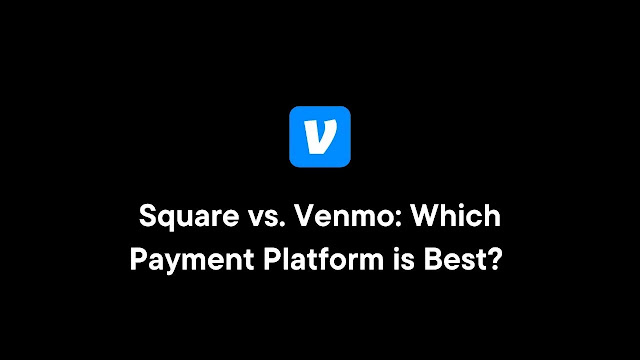Square vs. Venmo: A Simple Guide to Digital Payment Platforms
Compare Square vs. Venmo to find the best payment solution for your needs. Discover fees, features, and the ideal choice for businesses and personal
In today's digital age, mobile payment platforms have revolutionized the way individuals and businesses handle financial transactions. Among the myriad of options available, Square and Venmo have emerged as prominent players, each catering to distinct user needs. This article delves into a detailed comparison of these two platforms, examining their features, functionalities, and suitability for various use cases.
Venmo is a mobile payment service that facilitates peer-to-peer transactions, allowing users to send and receive money effortlessly. Its social features, such as transaction feeds and the ability to add comments or emojis, have made it particularly popular among younger demographics for casual payments and bill splitting.
Square, on the other hand, offers a comprehensive suite of payment solutions tailored primarily for businesses. Known for its point-of-sale (POS) systems, Square enables merchants to accept payments through various methods, including card readers and mobile devices. Its ecosystem encompasses inventory management, sales analytics, and invoicing, positioning it as a robust tool for business operations. Target Audience and Use Cases
Venmo:
Designed for personal transactions, Venmo excels in facilitating payments between friends and family. Its social interface allows users to share payment activities, making it ideal for splitting bills, sharing rent, or casual reimbursements. While Venmo has introduced business profiles, its core functionality remains centered around personal use.
Square:
Engineered for businesses of all sizes, Square provides tools that support both in-person and online sales. From small retailers to larger enterprises, Square's POS systems, invoicing capabilities, and inventory tracking cater to a wide range of business needs. Its focus is on streamlining operations and enhancing the customer payment experience.
Key Features Comparison
1. Payment Processing
Venmo:
- Peer-to-Peer Transactions: Facilitates free transfers between users when funded by a linked bank account or debit card.
- Credit Card Payments: Incurs a 3% fee for payments made using a credit card.
- Business Profiles: Allows small businesses and casual sellers to accept payments, though with limited business tools compared to dedicated business platforms.
Square:
- In-Person Payments: Charges 2.6% + $0.10 per transaction for card-present payments.
- Keyed-In Transactions: Incurs a fee of 3.5% + $0.15 per transaction for manually entered card payments.
- Online Payments: Offers e-commerce solutions with transaction fees varying based on the specific service utilized.
2. Transaction Limits
Venmo:
- Per Transaction Limit: Up to $3,000.
- Weekly Limit: Capped at $20,000 for payments sent or received.
Square:
- Individual Transactions: Limits start at $250 per transaction, with a weekly limit of $1,000 for unverified accounts.
- Business Accounts: Rolling 30-day limit of $250,000 in payments, with potential increases based on account history and verification.
3. Security Measures
Both platforms prioritize user security through:
- Data Encryption: Ensuring that all payment data is encrypted during transmission and storage to protect against unauthorized access.
- Fraud Detection: Utilizing advanced algorithms and monitoring systems to detect and prevent fraudulent activities.
Chargeback Protection:
- Square: Offers chargeback protection on eligible transactions, safeguarding merchants from losses due to disputes.
- Venmo: Does not provide specific chargeback protection but collaborates with users to investigate and resolve fraudulent incidents.
4. Mobile Application Experience
Venmo:
- User Interface: Features a social feed that displays transactions among friends, enhancing the communal aspect of payments.
- User Experience: Emphasizes ease of use with quick access to payment functions, transaction history, and social interactions.
Square:
- User Interface: Presents a clean and professional design tailored for business operations.
- User Experience: Focuses on functionality, offering tools for sales tracking, inventory management, and customer engagement.
5. Transfer Speed and Fees
Venmo:
- Standard Transfers: Free, typically completed within 1-3 business days.
- Instant Transfers: Available for a 1.75% fee, with a maximum charge of $25, enabling immediate access to funds.
Square:
- Standard Deposits: Processed next business day at no additional cost.
- Instant Transfers: Offered for a fee ranging from 0.5% to 1.75%, providing immediate fund availability.
Pros and Cons
Venmo
Pros:
- Social Integration: Enhances user engagement through social features, making transactions more interactive.
- User-Friendly Interface: Simplifies the process of sending and receiving money with a few taps.
Cons:
- Limited Business Features: Venmo is primarily designed for personal use, making it less ideal for businesses requiring advanced financial tools.
- Transaction Fees on Credit Cards: A 3% fee applies to transactions made with a credit card, which can add up over time.
Square
Pros:
- Comprehensive Business Tools: Offers POS systems, invoicing, and inventory management, making it an all-in-one solution for merchants.
- No Monthly Fees: Square operates on a pay-per-transaction model, eliminating the need for subscription costs.
Cons:
- Higher Fees for Some Transactions: Card-not-present and manually entered transactions incur higher fees.
- Not Ideal for Peer-to-Peer Transfers: Unlike Venmo, Square is not designed for casual money transfers between friends or family.
Which One Should You Choose?
For Personal Use: If your primary need is sending and receiving money among friends and family, Venmo is the better choice due to its ease of use, social features, and low-cost transactions.
For Business Use: Square is the clear winner for businesses looking for a professional payment solution, offering robust tools for managing transactions, inventory, and sales.
Conclusion
Both Square and Venmo serve distinct purposes in the digital payment landscape. Venmo excels in peer-to-peer transactions with its social-friendly interface, while Square is the go-to platform for businesses needing an integrated payment processing system. Understanding your specific needs will help determine the best option for you.


